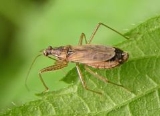
Nabidae
Encyclopedia
The insect family
Nabidae contains the damsel bugs. The terms damsel bug and nabid are synonymous. There are over 400 species. They are soft-bodied, elongate, winged terrestrial predators. Many damsel bugs catch and hold prey with their forelegs, similar to mantids. They are considered helpful species in agriculture
because of their predation on many types of crop pests, such as cabbage worm
s, aphid
s, and lygus bugs
.
Damsel bugs of the genus Nabis are the most common. They and other genera are most numerous in fields of legumes
such as alfalfa
, but they can be found in many other crops and in non-cultivated areas. They are yellow to tan in color and have large, bulbous eyes and stiltlike legs. They are generalist predators, catching almost any insect smaller than themselves, and cannibalizing each other when no other food is available.
Family (biology)
In biological classification, family is* a taxonomic rank. Other well-known ranks are life, domain, kingdom, phylum, class, order, genus, and species, with family fitting between order and genus. As for the other well-known ranks, there is the option of an immediately lower rank, indicated by the...
Nabidae contains the damsel bugs. The terms damsel bug and nabid are synonymous. There are over 400 species. They are soft-bodied, elongate, winged terrestrial predators. Many damsel bugs catch and hold prey with their forelegs, similar to mantids. They are considered helpful species in agriculture
Agriculture
Agriculture is the cultivation of animals, plants, fungi and other life forms for food, fiber, and other products used to sustain life. Agriculture was the key implement in the rise of sedentary human civilization, whereby farming of domesticated species created food surpluses that nurtured the...
because of their predation on many types of crop pests, such as cabbage worm
Cabbage worm
The term cabbage worm is primarily used for any of four kinds of lepidopteran whose larvae feed on cabbages and other cole crops. Host plants include broccoli, cauliflower, Brussels sprouts, collards, kale, mustard greens, turnip greens, radishes, turnips, rutabagas and kohlrabi...
s, aphid
Aphid
Aphids, also known as plant lice and in Britain and the Commonwealth as greenflies, blackflies or whiteflies, are small sap sucking insects, and members of the superfamily Aphidoidea. Aphids are among the most destructive insect pests on cultivated plants in temperate regions...
s, and lygus bugs
Lygus
The genus Lygus includes over 40 species of plant-feeding insects in the family Miridae. At one time, nearly 200 species were classified as genus Lygus, but most of those have since been reclassified into new or existing genera. The term lygus bug is used for any member of genus Lygus. The more...
.
Damsel bugs of the genus Nabis are the most common. They and other genera are most numerous in fields of legumes
Fabaceae
The Fabaceae or Leguminosae, commonly known as the legume, pea, or bean family, is a large and economically important family of flowering plants. The group is the third largest land plant family, behind only the Orchidaceae and Asteraceae, with 730 genera and over 19,400 species...
such as alfalfa
Alfalfa
Alfalfa is a flowering plant in the pea family Fabaceae cultivated as an important forage crop in the US, Canada, Argentina, France, Australia, the Middle East, South Africa, and many other countries. It is known as lucerne in the UK, France, Australia, South Africa and New Zealand, and known as...
, but they can be found in many other crops and in non-cultivated areas. They are yellow to tan in color and have large, bulbous eyes and stiltlike legs. They are generalist predators, catching almost any insect smaller than themselves, and cannibalizing each other when no other food is available.

